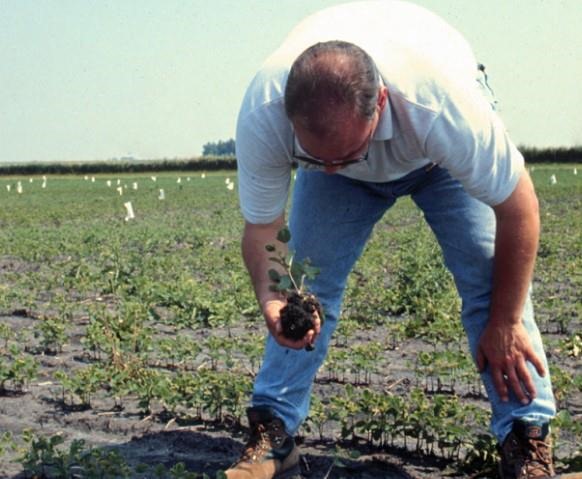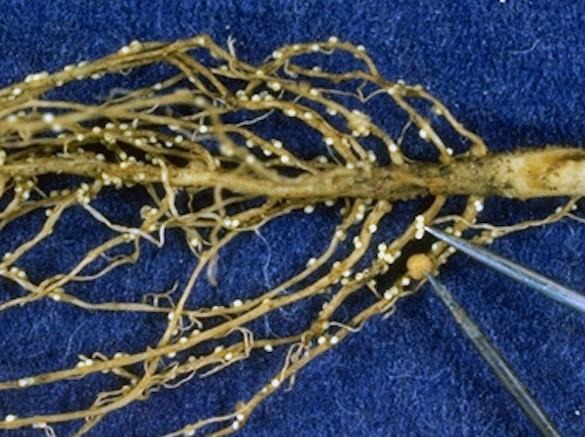By Greg Tylka
The best way to manage the soybean cyst nematode (SCN) is to grow SCN-resistant soybean varieties in rotation with the nonhost crop corn. Almost all soybean varieties planted by farmers in Iowa in 2022 contain SCN resistance genes from the breeding line PI 88788. Unfortunately, PI 88788 resistance has lost much or most of its effectiveness. Results of Iowa State University research indicate that yields of soybean varieties with PI 88788 SCN resistance can be more than 22 bu/ac less than yields of varieties possessing the effective but hard-to-come-by Peking SCN resistance - see article here.
Is SCN present in the fields in which you are growing soybeans in 2022?
Simply put, you can’t manage a problem you don’t know you have (or that you’ve forgotten about). SCN can reduce soybean yields without the beans looking sick. But SCN is not present in every field in Iowa or any other soybean-producing state. Thus, fields should be checked for the presence of SCN.
Looking for SCN females on soybean roots
Females of SCN can be seen on soybean roots with the unaided eye in late spring through mid-summer. And that means you can check fields for SCN simply by walking fields, digging some roots, and looking carefully for the nematode.
At ideal soil temperatures (78°F or warmer), it takes 24 to 28 days for adult SCN females to form. It may take up to six weeks after planting before the first adult SCN females appear on soybean roots because SCN development is slower in cool spring soils. Once the first adult SCN females of the season appear on roots, new females will be apparent on roots through the remainder of the growing season because not all SCN juveniles penetrate young soybean roots at the same time in the spring.
How to dig roots and what to look for
To check for SCN on soybean roots, dig (don't pull) roots from the soil (Figure 1) and gently shake the soil from the roots. If soil does not readily fall from the roots, break apart large clods of soil and crumble the soil away from the roots by hand. Adult SCN females form mostly on newer soybean roots, so take care not to strip away the smaller, younger soybean roots while removing soil from the roots. The adult SCN females are round, white objects visible with the unaided eye and are much smaller and lighter in color than nitrogen-fixing nodules that form on soybean roots (Figure 2).
 Figure 1. Digging soybean roots in late June to check for presence of SCN females.
Figure 1. Digging soybean roots in late June to check for presence of SCN females.
 Figure 2. Soybean roots with SCN females (three females in a row at the tip of the top pointer) and a nitrogen-fixing nodule (bottom pointer).
Figure 2. Soybean roots with SCN females (three females in a row at the tip of the top pointer) and a nitrogen-fixing nodule (bottom pointer).
Take an active approach to managing SCN
For decades, managing SCN required little effort because almost any SCN-resistant variety effectively reduced SCN reproduction and protected soybean yields. But after 25 years of using PI 88788 SCN resistance, SCN now is going mostly unmanaged. Actively managing SCN requires the following:
- Look for soybean varieties with PI 88788 SCN resistance that are consistently high yielding and provide good control of SCN. Iowa State University provides information on the SCN control and yield of hundreds of SCN-resistant soybean varieties annually. The publication is available for free online.
- Seek out and grow resistant soybean varieties with Peking and any other non-PI 88788 source of SCN resistance. Iowa State University Extension publishes an annually updated list of SCN-resistant soybean varieties for use in Iowa, and the list includes the genetic source of SCN resistance for each variety. The publication is available for free online.
- Continue growing corn, a SCN nonhost crop, in rotation with soybeans. See the article about the potential negative effects of growing beans on beans in SCN-infested fields.
- Consider using one of the many nematode-protectant seed treatments available for added protection against SCN, especially when growing soybean varieties with SCN resistance from PI 88788.
Source : iastate.edu